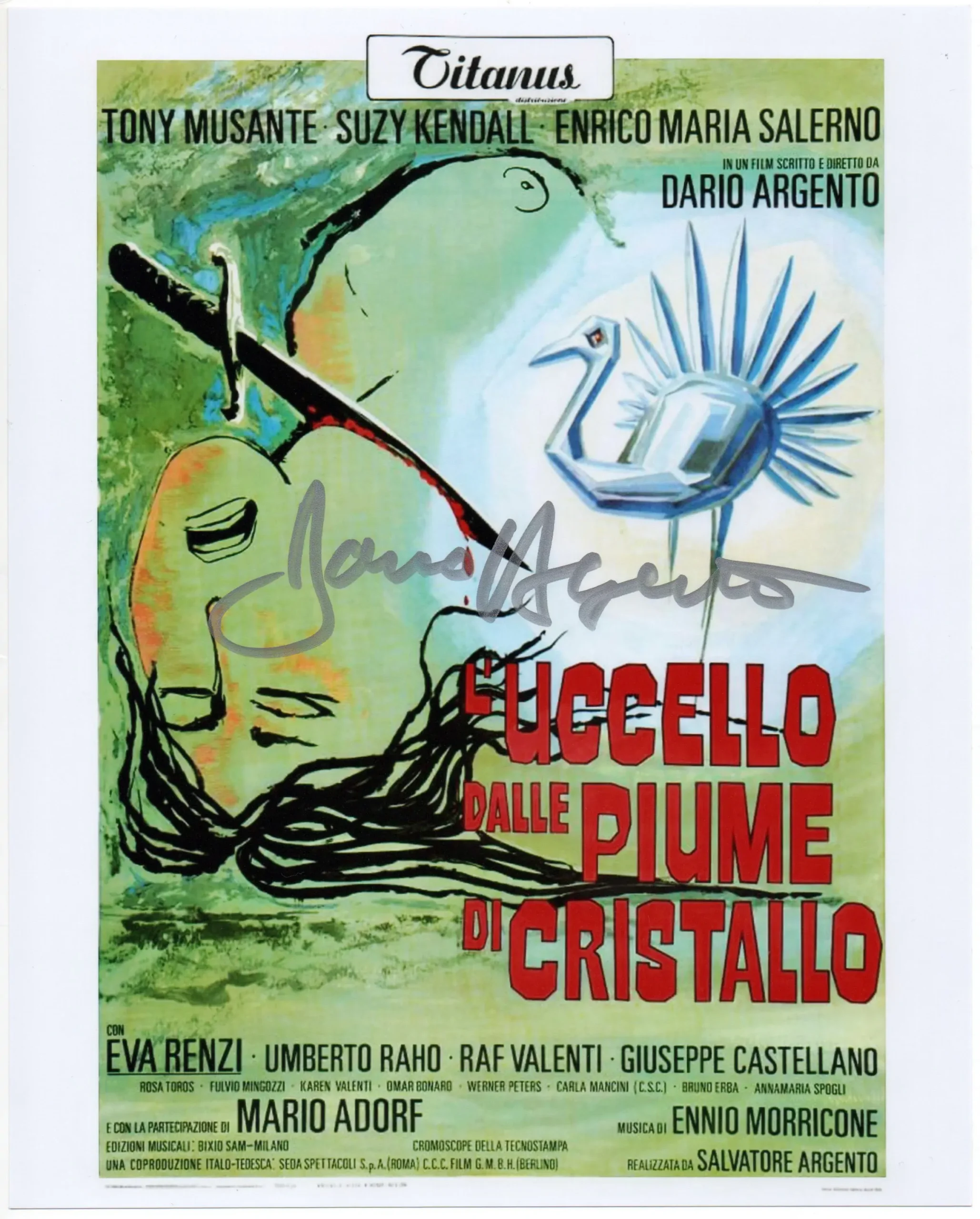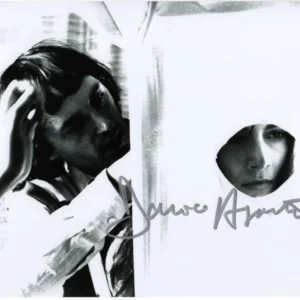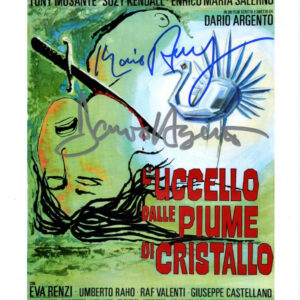Description
DARIO ARGENTO BIOGRAPHY:
Dario Argento is an Italian filmmaker and critic. His influential work in the horror genre during the 1970s and 1980s, particularly in the subgenre known as giallo, has led him to being referred to as the “Master of the Thrill” and the “Master of Horror”. His films as director include the “Animal Trilogy”, consisting of The Bird with the Crystal Plumage (1970), The Cat o’ Nine Tails (1971) and Four Flies on Grey Velvet (1971); the “Three Mothers” trilogy, consisting of Suspiria (1977), Inferno (1980) and The Mother of Tears (2007); and the standalone films Deep Red (1975), Tenebrae (1982), Phenomena (1985), and Opera (1987). He co-wrote the screenplay for Sergio Leone’s Once Upon a Time in the West (1968) and served as George A. Romero’s script consultant on Dawn of the Dead (1978), of which he also composed the soundtrack with his long-time collaborators Goblin.
Career
1970s
Argento began work on his directorial debut, the giallo film The Bird with the Crystal Plumage (L’uccello dalle piume di cristallo, 1970), which was a major hit in Italy. Argento continued to concentrate largely on the giallo genre, directing two more successful thrillers, The Cat o’ Nine Tails (Il gatto a nove code, 1971) and Four Flies on Grey Velvet (4 mosche di velluto grigio, 1972). Along with The Bird with the Crystal Plumage, these three films are frequently referred to as Argento’s “Animal Trilogy”. The director then turned his attention away from giallo movies, filming two Italian TV dramas and a period comedy, The Five Days (Le cinque giornate, 1973). Argento returned to thrillers with Deep Red (1975), frequently cited by many critics as the best giallo ever made. The film made Argento known internationally and inspired other directors to work in the genre. John Carpenter has frequently referred to the influence Argento’s early work had on Halloween (1978). Argento’s next film was Suspiria (1977), a supernatural horror. Argento planned for Suspiria to be the first of a trilogy about “The Three Mothers”, three ancient witches residing in three different modern cities. The second film of the trilogy was 1980’s Inferno. The Mother of Tears (2007) concluded the trilogy. In 1978, Argento collaborated with George A. Romero on Dawn of the Dead, earning a producer credit and also providing soundtrack work for the zombie film. Argento oversaw the European release of the film, where it was titled Zombi, which was much shorter and featured more of the score written and performed by Goblin.
1980s
After Inferno, Argento returned to the more conventional giallo style with Tenebrae (1982). He then attempted to combine giallo and supernatural fantasy in 1985’s Phenomena, also known as Creepers, which was one of Jennifer Connelly’s earliest movies. Phenomena also showed Argento’s predilection for using new technology, as evidenced by the film’s several prowling Steadicam shots. Both films received a lukewarm reception upon their release (although each has been positively reappraised since). Argento subsequently took a break from directing to write two screenplays for Mario Bava’s son, Lamberto Bava: Dèmoni (1985) and Dèmoni 2 (1986). Opera followed in 1987. Set in Parma’s Regio Theatre during a production of Verdi’s Macbeth, the production was beset by real-life misfortunes that Argento suspected were caused by the supposed traditional “curse” on the Shakespearean play. Argento’s father died during its production, Vanessa Redgrave quit the project before filming began, he had problems working with his former long-time girlfriend and collaborator Daria Nicolodi on-set, and the cast and crew were plagued by several minor accidents and mishaps. In 1987–88, Argento produced a TV series called Turno di Notte, which had 15 episodes. Nine of the shows were directed by Luigi Cozzi, the other six by Lamberto Bava. Daria Nicolodi and Asia Argento starred in several of the episodes.
1990s
During the early 1990s, Argento was in the process of collaborating with Italian director Lucio Fulci on a horror film. Due to financial trouble, the project was continually postponed. In 1996, Argento was able to gather funding, but was unable to collaborate with Fulci, who died in March that year. The film was later directed by Sergio Stivaletti as The Wax Mask, with Argento and Fulci both receiving screenwriting credits. His 1996 film The Stendhal Syndrome, in which a policewoman (played by Argento’s daughter, Asia) who suffers from Stendhal syndrome is trapped by a serial killer in an abandoned warehouse, was the first Italian film to use computer-generated imagery. Moreover, the film’s opening scene was shot in Florence at Italy’s famed Uffizi Gallery. Argento is the only director ever granted permission to shoot there. The Stendhal Syndrome was distributed in the U.S. by cult B-movie distribution company Troma Entertainment. He later directed 1998’s The Phantom of the Opera and 2001’s Sleepless.
2000s and 2010s
2004’s The Card Player, a giallo about a killer whose murders are conducted during Internet poker matches with the Rome police, earned a mixed reception; some fans appreciated the techno music score composed by ex-Goblin member Claudio Simonetti, but felt the film was too mainstream, with little of Argento’s usual flourish. In the 2005 TV broadcast of Argento’s Do You Like Hitchcock?, the director paid homage to Alfred Hitchcock after decades of being compared to him by critics. Later that year, he directed an episode of Masters of Horror, a Showtime television series, called “Jenifer”. For season two of the series, Argento directed “Pelts”, an adaption of the F. Paul Wilson short story of the same name. In 2007, Argento finished the final film of his Three Mothers trilogy, The Mother of Tears, which is set in Rome and centers on the titular “third mother”, Mater Lacrimarum. Argento and Jace Anderson share writing credits for the film. Asia Argento was cast as the lead player, along with her mother and frequent Argento collaborator Daria Nicolodi in a supporting role. Udo Kier, who appeared in Argento’s Suspiria, and Coralina Cataldi-Tassoni, who appeared in three of his previous films, both have pivotal roles in the final Mothers chapter. On 26 June 2009, Giallo premiered at the Edinburgh Film Festival. The following month, he announced that he had started working on a 3D remake of Deep Red, but subsequently this project was shelved due to the commercial failure of Giallo in Italian cinemas. He then announced his decision to write a new screenplay. On 4 March 2011, it was announced that Rutger Hauer had signed on to play Van Helsing in Argento’s Dracula 3D, which began shooting in Budapest later in the year. It was released on 19 May 2012. In 2014, Argento was slated to direct The Sandman, which had Iggy Pop attached to star and a script by David Tully. The film successfully raised over $195,000 from over 1,000 backers on Indiegogo in December 2014. However, filming has not commenced as of 2019, and the project producers have not updated the film’s status to backers since August 2017. Italian director Luca Guadagnino helmed Suspiria (2018), a remake of Argento’s 1977 film. The American screenplay is based on the original script Argento wrote with Daria Nicolodi, his former long-term partner. In 2019, Argento announced that he was developing a female-led serial movie, consisting of eight episodes, for a streaming service. In March 2019, Argento was announced as the “artistic director” on Clod Studio’s crowdfunded video game Dreadful Bond.
1970s
Argento began work on his directorial debut, the giallo film The Bird with the Crystal Plumage (L’uccello dalle piume di cristallo, 1970), which was a major hit in Italy. Argento continued to concentrate largely on the giallo genre, directing two more successful thrillers, The Cat o’ Nine Tails (Il gatto a nove code, 1971) and Four Flies on Grey Velvet (4 mosche di velluto grigio, 1972). Along with The Bird with the Crystal Plumage, these three films are frequently referred to as Argento’s “Animal Trilogy”. The director then turned his attention away from giallo movies, filming two Italian TV dramas and a period comedy, The Five Days (Le cinque giornate, 1973). Argento returned to thrillers with Deep Red (1975), frequently cited by many critics as the best giallo ever made. The film made Argento known internationally and inspired other directors to work in the genre. John Carpenter has frequently referred to the influence Argento’s early work had on Halloween (1978). Argento’s next film was Suspiria (1977), a supernatural horror. Argento planned for Suspiria to be the first of a trilogy about “The Three Mothers”, three ancient witches residing in three different modern cities. The second film of the trilogy was 1980’s Inferno. The Mother of Tears (2007) concluded the trilogy. In 1978, Argento collaborated with George A. Romero on Dawn of the Dead, earning a producer credit and also providing soundtrack work for the zombie film. Argento oversaw the European release of the film, where it was titled Zombi, which was much shorter and featured more of the score written and performed by Goblin.
1980s
After Inferno, Argento returned to the more conventional giallo style with Tenebrae (1982). He then attempted to combine giallo and supernatural fantasy in 1985’s Phenomena, also known as Creepers, which was one of Jennifer Connelly’s earliest movies. Phenomena also showed Argento’s predilection for using new technology, as evidenced by the film’s several prowling Steadicam shots. Both films received a lukewarm reception upon their release (although each has been positively reappraised since). Argento subsequently took a break from directing to write two screenplays for Mario Bava’s son, Lamberto Bava: Dèmoni (1985) and Dèmoni 2 (1986). Opera followed in 1987. Set in Parma’s Regio Theatre during a production of Verdi’s Macbeth, the production was beset by real-life misfortunes that Argento suspected were caused by the supposed traditional “curse” on the Shakespearean play. Argento’s father died during its production, Vanessa Redgrave quit the project before filming began, he had problems working with his former long-time girlfriend and collaborator Daria Nicolodi on-set, and the cast and crew were plagued by several minor accidents and mishaps. In 1987–88, Argento produced a TV series called Turno di Notte, which had 15 episodes. Nine of the shows were directed by Luigi Cozzi, the other six by Lamberto Bava. Daria Nicolodi and Asia Argento starred in several of the episodes.
1990s
During the early 1990s, Argento was in the process of collaborating with Italian director Lucio Fulci on a horror film. Due to financial trouble, the project was continually postponed. In 1996, Argento was able to gather funding, but was unable to collaborate with Fulci, who died in March that year. The film was later directed by Sergio Stivaletti as The Wax Mask, with Argento and Fulci both receiving screenwriting credits. His 1996 film The Stendhal Syndrome, in which a policewoman (played by Argento’s daughter, Asia) who suffers from Stendhal syndrome is trapped by a serial killer in an abandoned warehouse, was the first Italian film to use computer-generated imagery. Moreover, the film’s opening scene was shot in Florence at Italy’s famed Uffizi Gallery. Argento is the only director ever granted permission to shoot there. The Stendhal Syndrome was distributed in the U.S. by cult B-movie distribution company Troma Entertainment. He later directed 1998’s The Phantom of the Opera and 2001’s Sleepless.
2000s and 2010s
2004’s The Card Player, a giallo about a killer whose murders are conducted during Internet poker matches with the Rome police, earned a mixed reception; some fans appreciated the techno music score composed by ex-Goblin member Claudio Simonetti, but felt the film was too mainstream, with little of Argento’s usual flourish. In the 2005 TV broadcast of Argento’s Do You Like Hitchcock?, the director paid homage to Alfred Hitchcock after decades of being compared to him by critics. Later that year, he directed an episode of Masters of Horror, a Showtime television series, called “Jenifer”. For season two of the series, Argento directed “Pelts”, an adaption of the F. Paul Wilson short story of the same name. In 2007, Argento finished the final film of his Three Mothers trilogy, The Mother of Tears, which is set in Rome and centers on the titular “third mother”, Mater Lacrimarum. Argento and Jace Anderson share writing credits for the film. Asia Argento was cast as the lead player, along with her mother and frequent Argento collaborator Daria Nicolodi in a supporting role. Udo Kier, who appeared in Argento’s Suspiria, and Coralina Cataldi-Tassoni, who appeared in three of his previous films, both have pivotal roles in the final Mothers chapter. On 26 June 2009, Giallo premiered at the Edinburgh Film Festival. The following month, he announced that he had started working on a 3D remake of Deep Red, but subsequently this project was shelved due to the commercial failure of Giallo in Italian cinemas. He then announced his decision to write a new screenplay. On 4 March 2011, it was announced that Rutger Hauer had signed on to play Van Helsing in Argento’s Dracula 3D, which began shooting in Budapest later in the year. It was released on 19 May 2012. In 2014, Argento was slated to direct The Sandman, which had Iggy Pop attached to star and a script by David Tully. The film successfully raised over $195,000 from over 1,000 backers on Indiegogo in December 2014. However, filming has not commenced as of 2019, and the project producers have not updated the film’s status to backers since August 2017. Italian director Luca Guadagnino helmed Suspiria (2018), a remake of Argento’s 1977 film. The American screenplay is based on the original script Argento wrote with Daria Nicolodi, his former long-term partner. In 2019, Argento announced that he was developing a female-led serial movie, consisting of eight episodes, for a streaming service. In March 2019, Argento was announced as the “artistic director” on Clod Studio’s crowdfunded video game Dreadful Bond.




